 ARMA
Editorial
ARMA
Editorial
"To
Spar or Not to Spar?"…that is the question
The mimic fight, and sweat with spear and sword:
And through the discipline such nurture yields,
Shall flourish as the flower of martial fields.
- Ludovico Ariosto, 1523
By J. Clements
I
have occasionally encountered the view that training in Renaissance
fencing historically involved no form of free-play or mock combat
–what we would now commonly refer to as sparring
(a term every reasonable person understands the meaning of). I’ve also sometimes even encountered the belief
(prominent among some traditional Asian stylists) that in real martial
arts sparring has no value or place in the preparation of warriors
for personal combat. In modern
sport fencing it is also standard to restrict students from any
form of bouting for a considerable length of time until they have
acquired the necessary foundational form. This bouting is always
conducted within a tightly controlled framework of permissible actions
that directs the play far from its original martial purpose and
thus exclusively into the realm of sport.
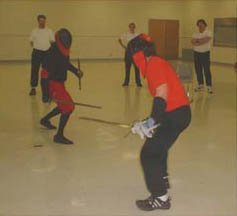 Not
only do I disagree with these perspectives, our research within
Renaissance martial arts has revealed considerable evidence from
the 12th to 17th centuries for several forms of mock combat used
in Europe as earnest self-defense training,
battlefield rehearsal, ritual display, and sporting contest (I document
a wealth of this information in one of my forthcoming books).
From tournaments to prize playing to bouting a few veneys
and impromptu scrimmaging, the evidence is substantial -and this
activity involved substantial contact not merely pulled blows or
surface touches. In fact, examination of the methods by which this
kind of “contact-sparring” was pursued (its equipment, safety rules,
intent, techniques, etc.) is a main area of our studies.
Not
only do I disagree with these perspectives, our research within
Renaissance martial arts has revealed considerable evidence from
the 12th to 17th centuries for several forms of mock combat used
in Europe as earnest self-defense training,
battlefield rehearsal, ritual display, and sporting contest (I document
a wealth of this information in one of my forthcoming books).
From tournaments to prize playing to bouting a few veneys
and impromptu scrimmaging, the evidence is substantial -and this
activity involved substantial contact not merely pulled blows or
surface touches. In fact, examination of the methods by which this
kind of “contact-sparring” was pursued (its equipment, safety rules,
intent, techniques, etc.) is a main area of our studies.
But, what struck me was how it’s been argued by
some martial artists (and even a few historical fencing practitioners)
that bouts of mock combat play somehow would not properly prepare
an individual for the realities and necessities of lethal armed
combat; and further, that such training could only be achieved by
performing set patterns of movements and prearranged drills. I’ve
always disagreed with this claim and have always maintained the
value of loose play (a view which, as I indicated, we’ve discovered
is born out by a wide range of historical European sources).
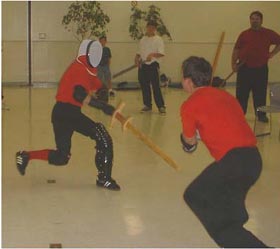 Here
we essentially have an argument which follows a line of reasoning
that says: In order to prepare for the exigency of actual combat,
you above all need to learn and practice formal exercises in a set
pattern. In other words, two students, the first saying to the second,
“When you are ready I will make this specific attack and you will
counter with that specific defense” and the second student responding,
“Yes, you make that specific attack and I will defend with this
specific counter.” Where
as, by contrast, in free-play each of the students essentially says
one to another: “I’m not going to let you know exactly when or where
or how, or even if, I’m going to attack or defend, so get yourself
ready.”
Here
we essentially have an argument which follows a line of reasoning
that says: In order to prepare for the exigency of actual combat,
you above all need to learn and practice formal exercises in a set
pattern. In other words, two students, the first saying to the second,
“When you are ready I will make this specific attack and you will
counter with that specific defense” and the second student responding,
“Yes, you make that specific attack and I will defend with this
specific counter.” Where
as, by contrast, in free-play each of the students essentially says
one to another: “I’m not going to let you know exactly when or where
or how, or even if, I’m going to attack or defend, so get yourself
ready.”
Now I ask, in all honestly, which one of the above
scenarios most resembles the actualities of real fighting? Which is going to be better for teaching a fighter
to spontaneously respond reflexively to any tactical possibility? If a student only follows the first method and
another student combines both methods, who is going to be the better
prepared for the unknowns of violent combat?
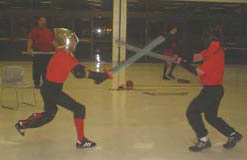 I
also have noted that one argument against utilizing safe mock-combat with weapons as a tool for
study is that it is not “real enough.” This
argument however begs the question, “Isn’t
it more realistic than just performing structured movements and
drills?” [to such anti-sparring advocates, we might also ask, “If it
were made even more realistic would you then participate in it as
a valid means of training?”]. Some
object to free-play as not being beneficial for learning how to
fight because actions and techniques do indeed behave differently
under full effort and power than under the generally softer controlled
conditions of safe play. In earnest fighting, the commitment and
urgency behind strikes may not be as easily defended or warded as
they can be in mock combat. Yet, ironically, one of the very values of playing
is to help build a fighter’s awareness of their vulnerabilities
and weaknesses. It permits them to explore their capabilities and
extend their capacity to read an opponent’s intentions and actions
–with fewer restrictions than drilling set movements.
I
also have noted that one argument against utilizing safe mock-combat with weapons as a tool for
study is that it is not “real enough.” This
argument however begs the question, “Isn’t
it more realistic than just performing structured movements and
drills?” [to such anti-sparring advocates, we might also ask, “If it
were made even more realistic would you then participate in it as
a valid means of training?”]. Some
object to free-play as not being beneficial for learning how to
fight because actions and techniques do indeed behave differently
under full effort and power than under the generally softer controlled
conditions of safe play. In earnest fighting, the commitment and
urgency behind strikes may not be as easily defended or warded as
they can be in mock combat. Yet, ironically, one of the very values of playing
is to help build a fighter’s awareness of their vulnerabilities
and weaknesses. It permits them to explore their capabilities and
extend their capacity to read an opponent’s intentions and actions
–with fewer restrictions than drilling set movements.
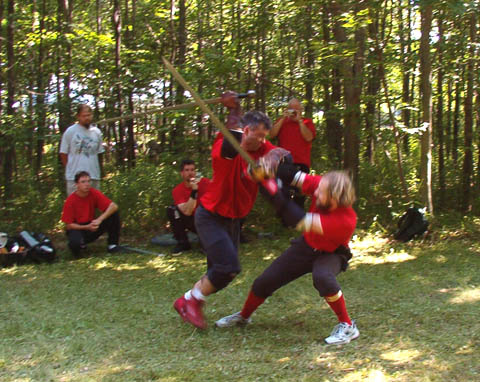 But
because rules designed to permit students to safely practice-fight must inherently create boundaries
that limit freedom of action, some martial artists feel skill developed
in this way builds artificial confidence. The fighter, they argue, only learns to “play
fight”. This would be true if free-play were used alone, but when
combined with serious drills and exercises designed to realistically
teach proper form and correct execution of actions, free-play then
becomes very effective in developing a student’s skill. Historically,
guidelines for what was or wasn’t acceptable were always a part
of mock combat. After all, it is not hard to imagine that armed
men living in a violent age might resort to real fighting if they
were either injured or embarrassed by loss in a practice bout. So,
things had to be conducted with some degree of structure and formality
(not that this alleviated all the risk). Besides,
it would be hard to learn if every student was going around causing
real wounds on their practice partners.
But
because rules designed to permit students to safely practice-fight must inherently create boundaries
that limit freedom of action, some martial artists feel skill developed
in this way builds artificial confidence. The fighter, they argue, only learns to “play
fight”. This would be true if free-play were used alone, but when
combined with serious drills and exercises designed to realistically
teach proper form and correct execution of actions, free-play then
becomes very effective in developing a student’s skill. Historically,
guidelines for what was or wasn’t acceptable were always a part
of mock combat. After all, it is not hard to imagine that armed
men living in a violent age might resort to real fighting if they
were either injured or embarrassed by loss in a practice bout. So,
things had to be conducted with some degree of structure and formality
(not that this alleviated all the risk). Besides,
it would be hard to learn if every student was going around causing
real wounds on their practice partners.
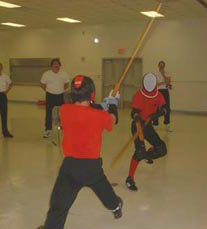 Additionally,
some martial artists may object to free-play on the grounds that
to conduct it with enough intensity, too much protective equipment
must be employed, which invariably modifies the activity too much.
The more body protection one adopts in mock combat for safety, the
less concern one might have for the risks of being injured by blows,
which would then affect motivations of how the combatants perform.
However, this is a factor even in real combat, where protective
armor does indeed give one more confidence for facing particular
conditions. So, the argument that free-play is distorting because
it's “not real” runs counter to the very nature of the exercise
as a tool for learning in the first place. It would be hard to imagine
learning to wrestle without actually wrestling, or learning to box
without actually boxing. And each of these activities, even when
conducted as sport, can have a corresponding real-world lethal self-defense
application. So it was with historical fencing. The learning of fighting arts in Medieval and
Renaissance Europe involved practice fighting.
Additionally,
some martial artists may object to free-play on the grounds that
to conduct it with enough intensity, too much protective equipment
must be employed, which invariably modifies the activity too much.
The more body protection one adopts in mock combat for safety, the
less concern one might have for the risks of being injured by blows,
which would then affect motivations of how the combatants perform.
However, this is a factor even in real combat, where protective
armor does indeed give one more confidence for facing particular
conditions. So, the argument that free-play is distorting because
it's “not real” runs counter to the very nature of the exercise
as a tool for learning in the first place. It would be hard to imagine
learning to wrestle without actually wrestling, or learning to box
without actually boxing. And each of these activities, even when
conducted as sport, can have a corresponding real-world lethal self-defense
application. So it was with historical fencing. The learning of fighting arts in Medieval and
Renaissance Europe involved practice fighting.
Historically, whatever combative system a
person was studying, if that system had real combat value it would
be discovered soon enough when the person actually had to fight.
The only way to test this before hand was to engage in some sort
of play combat ("sparring"). Otherwise, the skills needed
for violent encounters (adversarial counter-timing, controlling
distance and initiative, deceiving and not being deceived, etc.)
would be missing and you might have someone who could dance around
very prettily, but not really fight.
It would seem such an incredibly natural thing to do, for two people
practicing fencing, to say to one another, "Ok, we've done
a lot of drilling in basic actions and exercising in delivering
techniques and counter-techniques, let's try our hand a little at
putting it all together and test ourselves." How else do you
possibly prepare yourself to actually fight unless you first gauge
in this way your own speed, strength, caution, and courage? What
better way for students to test one another than to say, "Try
to hit me" or "Defend yourself from my blows"?
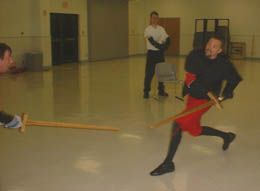 I
can understand however, if a martial artist wanted to avoid free-play
because they were just not very good at it, that it might lead them
to disavow its usefulness as a means of learning if they did not
“do well”. After all, it could certainly be disconcerting for anyone,
whether a senior instructor or a novice student, to be “out fought”
in mock battle by someone they deemed to have noticeably inferior
ability or training. After more than two and a half decades doing
all manner of armed free-play, I myself occasionally encounter those
who by youthful speed and enthusiasm alone are able to make good
contact on me as many as one out of three times. Reasonably, considering
my substantial skills and experience they should not be able to
hit me even one out of ten times. Given that, this is just free-play
and does not contain the level of apprehension or hesitation or
anywhere near the emotional content and angst that we understand
occurs in real life and death combat, I can hardly find such outcomes
disturbing. I am confident knowing I could fight far harder with
lethal intent and attitude precisely because of my superior technical
know-how and conditioning, which allows me to put such encounters
into proper context. Besides, the results of free-play vary significantly
depending upon the equipment and rules played under. That’s why
in Renaissance martial arts we try to do such a variety of it. Free
play is indeed “pretend” fighting because that's how historically
they safely prepared for the real thing.
I
can understand however, if a martial artist wanted to avoid free-play
because they were just not very good at it, that it might lead them
to disavow its usefulness as a means of learning if they did not
“do well”. After all, it could certainly be disconcerting for anyone,
whether a senior instructor or a novice student, to be “out fought”
in mock battle by someone they deemed to have noticeably inferior
ability or training. After more than two and a half decades doing
all manner of armed free-play, I myself occasionally encounter those
who by youthful speed and enthusiasm alone are able to make good
contact on me as many as one out of three times. Reasonably, considering
my substantial skills and experience they should not be able to
hit me even one out of ten times. Given that, this is just free-play
and does not contain the level of apprehension or hesitation or
anywhere near the emotional content and angst that we understand
occurs in real life and death combat, I can hardly find such outcomes
disturbing. I am confident knowing I could fight far harder with
lethal intent and attitude precisely because of my superior technical
know-how and conditioning, which allows me to put such encounters
into proper context. Besides, the results of free-play vary significantly
depending upon the equipment and rules played under. That’s why
in Renaissance martial arts we try to do such a variety of it. Free
play is indeed “pretend” fighting because that's how historically
they safely prepared for the real thing.
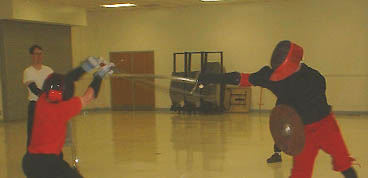 No
one is suggesting that a student should not first learn proper fundamental
form and basic core movements before engaging in mock-combat as a training tool. Just that,
armed free-play is, by its function, self-instructing. For the beginning student it is more a matter
of learning how to do it safely with freedom of action more than
how to do it “properly” according to a proscribed “style.” If
it’s intended as a tool for martial training, then free-play should
never be just a mere game of speed tag or a sport of scoring points.
[In fact, we feel so strongly about avoiding this that we work actively
to warn practitioners to avoid these problems.]
No
one is suggesting that a student should not first learn proper fundamental
form and basic core movements before engaging in mock-combat as a training tool. Just that,
armed free-play is, by its function, self-instructing. For the beginning student it is more a matter
of learning how to do it safely with freedom of action more than
how to do it “properly” according to a proscribed “style.” If
it’s intended as a tool for martial training, then free-play should
never be just a mere game of speed tag or a sport of scoring points.
[In fact, we feel so strongly about avoiding this that we work actively
to warn practitioners to avoid these problems.]
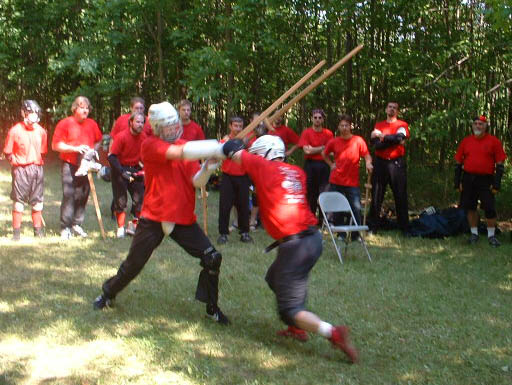 Granted
there are some movements which reasonably must be suitably modified
for safety (such as breaking joints or striking to the eyes and
throat), but if something does not work in free-play how can we
argue it would then work in real fighting? Now understandably, the
more any martial art is made into a game or sport revolving around
artificial rules and restrictive conditions, the less concern there
is for the brutality and earnest application of lethal technique.
The gulf between edged-weapon theory and practical reality
is never wider than when historical fighting skills of life and
death are transformed into rule-enshrined competitive sports surrounded
by formal protocols and contrived etiquettes. Only "play-fighting"
can certainly engender bad habits and a lack of appreciation for
the inherent violence of real fighting.
Granted
there are some movements which reasonably must be suitably modified
for safety (such as breaking joints or striking to the eyes and
throat), but if something does not work in free-play how can we
argue it would then work in real fighting? Now understandably, the
more any martial art is made into a game or sport revolving around
artificial rules and restrictive conditions, the less concern there
is for the brutality and earnest application of lethal technique.
The gulf between edged-weapon theory and practical reality
is never wider than when historical fighting skills of life and
death are transformed into rule-enshrined competitive sports surrounded
by formal protocols and contrived etiquettes. Only "play-fighting"
can certainly engender bad habits and a lack of appreciation for
the inherent violence of real fighting.
Of course, the very same flaw can be said of ritualistic
exercises and the inflexible pre-programmed approach to training.
But, unlike the latter, the more realistically free-play is conducted,
the more it sharpens reflexes, develops perception, teaches adversarial
counter-timing, explores spontaneous tactics, conveys the skill
of deceiving without being deceived, and lets the student try things
that end up with them either getting whacked or not, but in the
process not being maimed or killed. That sounds like quite a benefit from such a
simple and obvious activity.

